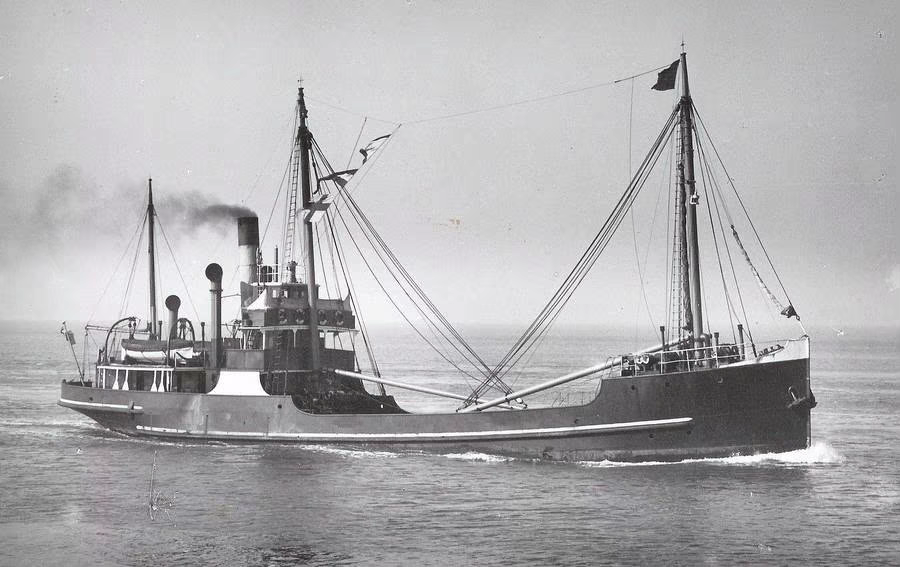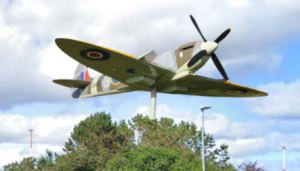Site 3. H.M.A.V. Isleford
HMAV Isleford (His Majesty’s Armed Vessel) was a small coastal steamer that was operated by the Royal Navy as a naval armament vessel during both World Wars. Measuring 150 feet (46m) long by 25½ feet (8m) wide and with a draught of 10 feet(3m), the small vessel had a total gross weight of 414 tons.
Originally launched on the 8th December 1912 by the Ardrossan Dry Dock Yard & Shipbuilding Co. Ltd. as a motor vessel for Messrs Mann and McNeil of Glasgow, the Isleford was then purchased by the Admiralty for service as a Royal Fleet Auxiliary a few months later on the 26th March 1913.
She served throughout World War One at the Royal Navy Dockyard in Portsmouth and continued to operate on the south coast until the outbreak of World War Two when she was transferred north to service the Home Fleet in its Scottish bases at Scapa Flow and the Cromarty Firth.
On the 24th January 1942 she set sail from Lyness in Orkney under the command of Captain David Andrew Foalle with a crew of fourteen destined for Invergordon in the Cromarty Firth. The vessel had a cargo of mixed naval munitions including mines and various sizes of naval shells.
The Isleford steamed south through the night and gale force winds whipped up a very rough sea as she ploughed through the waves towards the naval base at Invergordon. Shortly after passing Wick she developed engine trouble and lost propulsion. At the mercy of the ferocious waves the crew put up distress flares which were spotted at Sarclet four miles south of Wick at 22:30 by coast watchers.
The Coast Guard at Wick were informed but due to the weather conditions the lifeboat from Wick was unable to be launched from the lifeboat shed at the south side of the bay. The lifeboat from Cromarty was called but this would take quite some time to reach the Isleford, so the LSA (Life Saving Apparatus) crew were put on standby in case the Isleford was swept close to shore.
The direction of the wind was pushing the Isleford northwards and into Wick Bay, and she was picked up by the Coastal Artillery Searchlights below Broadhaven as she was tossed about in the huge waves rolling into the bay. As the ship was driven closer to the north side of Wick Bay, the LSA crew set up on the north shore in a position where they expected the Isleford would run aground, and waited for her to draw closer.

In the early hours of the 25th the Isleford was dashed onto the rocks below Broadhaven and broke in two. The bow of the ship was almost immediately swept away as the crew clung on near the bridge. The LSA crew went into action and fired rockets over the Isleford in an effort to get a line to the wreck, but in the atrocious conditions this proved extremely difficult. The rescuers could only watch in horror as the men aboard were swept away one by one until all 15 were lost to the sea.
As dawn broke the shoreline was littered with wreckage and munitions from the ship’s deadly cargo. The bodies of two of the crew were recovered, but mines that the Isleford had been carrying were strewn along the shore or within the shallows of the north side of the bay. This constituted a considerable risk to the town. Each mine weighing half a ton, and containing 400lbs(180kg) of TNT, was carefully removed from the shore or lifted out of the water by hand and carried to a central collection point. Wooden crates containing shells were also collected, but it was quite clear that the ship had not given up all of its cargo and a considerable amount of munitions lay scattered across the seabed of the bay.
The wreck lay fairly undisturbed for almost 50 years although some of the cargo was removed in the 1950s. In the early 90s she was surveyed again to determine if the unrecovered munitions represented a danger. It was decided that the area did require to be made safe and clearance diving operations were carried out in June and July of 1992 by the Royal Navy. Substantial quantities of ammunition were removed, but several 14” (36cm) naval shells along with other munitions were left undisturbed as the majority were considered inactive.
On the 16th of April 2012 the wreck of HMAV Isleford was made a designated wreck under the Protection of Military Remains Act1986 (Designation of Vessels and Controlled Sites) Order 2012. A memorial plaque was placed on what remained of her engine in September 2014 by the Merchant Navy Association.
Today the wreck of the Isleford lies on the north side of Wick Bay in about 52 feet (16m) of water. Her boiler, engine, rudder,prop-shaft, and part of the hull and keel are still visible. During the winter months when the kelp has reduced, boxes of ammunition with their contents still intact can be seen by divers along with some of the 14″ (36cm) naval shells. From time to time munitions do still wash ashore in Wick Bay, but these are quickly dealt with by the Ministry of Defence.
In remembrance of those lost on 25th January 1942 onboard HMAV Isleford
David A. K. Foalle – Captain
William A. Hall – Chief Officer
Hector MacNichol – 2nd Officer
Horace D. Gumbell – Chief Engineer Officer
William A. Cleghorn – 2nd Engineer Officer
John F. Clark – DEMS Gunner
Cyril S. Cook – Able Bodied Seaman
Victor D. Kingdom – Able Bodied Seaman
William Witham – Able Bodied Seaman
Roy C. McGrane – Ordinary Seaman
George W. Smith – Ordinary Seaman
Harry J. Lawrence – Fireman
Frank Rawlins – Fireman
Harry Rowe – Boy Seaman
Sydney G. Davis – Boy Seaman


